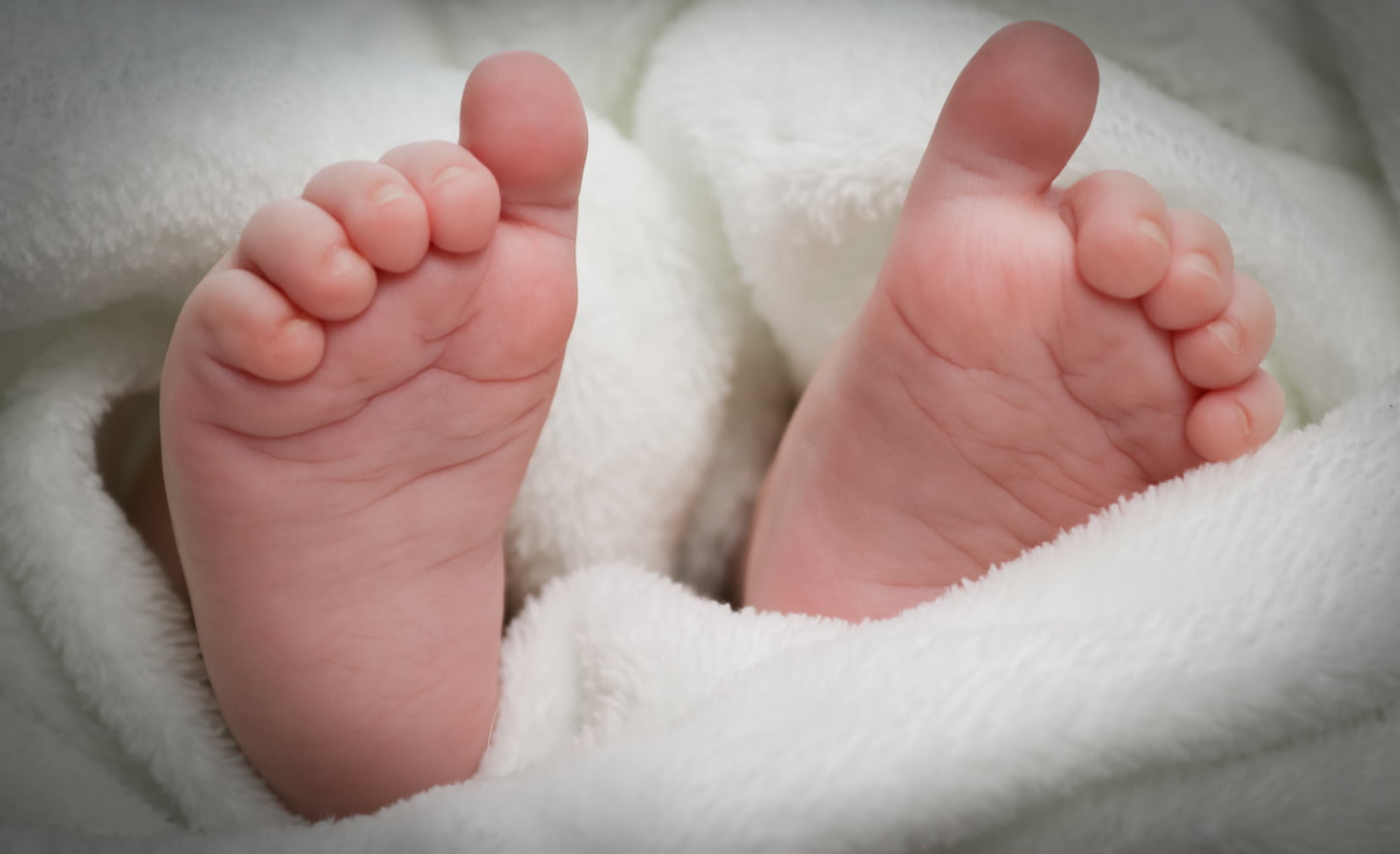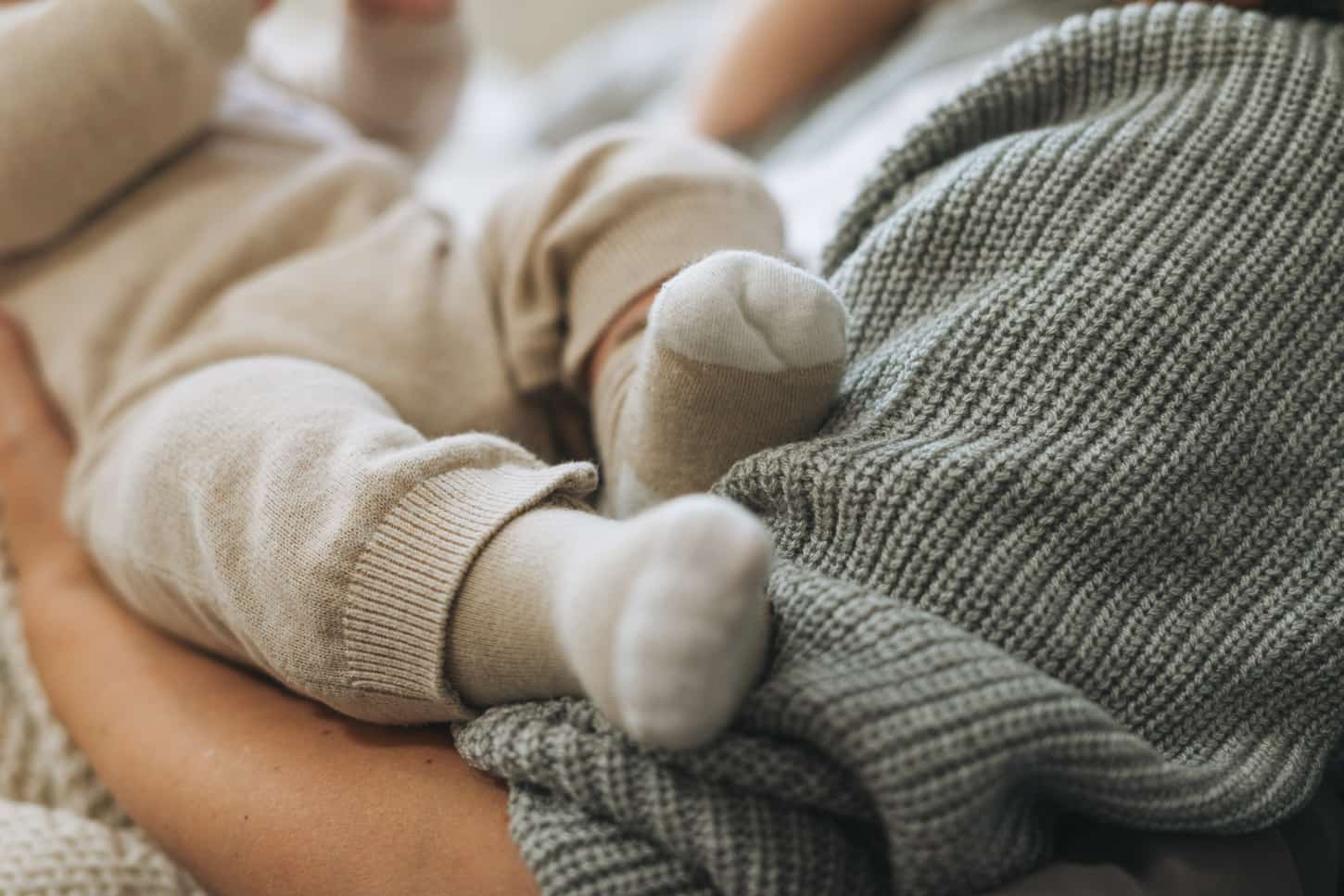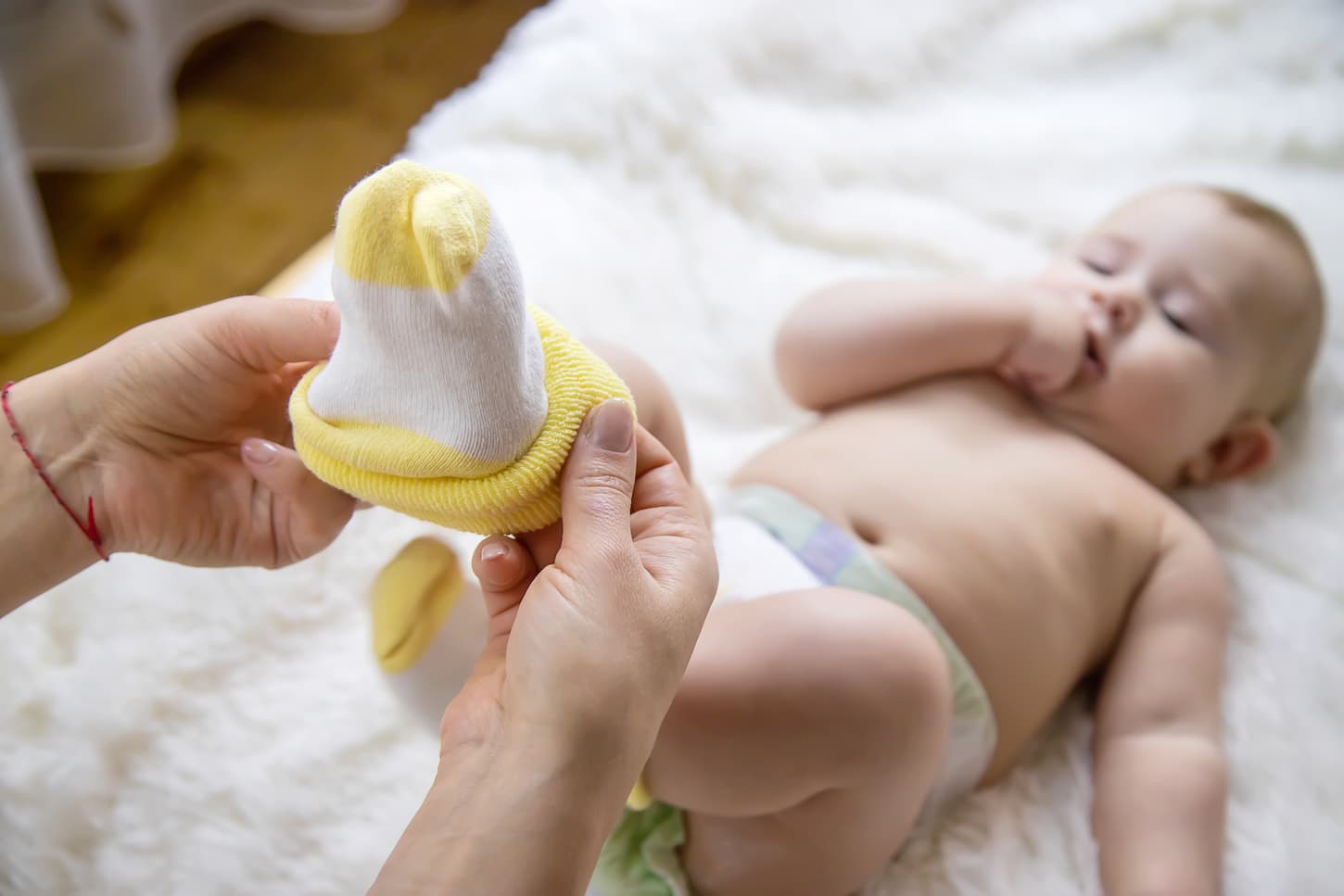A happy and healthy child is a parent’s focus. There are many ways to benefit a child’s development and peaceful sleep is up at the top. It’s difficult for a person of any age to sleep if they are not comfortable and having cold feet can be distracting and prevent drifting off. So, can a baby wear socks while sleeping?
Babies can wear socks while sleeping, and it is a great way to layer a baby and keep them warm so they can sleep comfortably. Babies who wear socks regularly should always have socks and clothing removed regularly to inspect their skin for sores, issues, and hair tourniquets.
We’ve explored the subject to help you decide if wrapping up your baby’s feet is going to be best for them and for you to ensure a peaceful night (and even at nap time).

Can Infants Wear Socks to Bed?
The main reason for putting socks on a baby is warmth. Newborn babies can’t regulate body temperature like adults can. Babies rely on clothing to help keep them comfortable and cozy. As the temperature is usually lower at night, additional layers help babies stay warm and sleep soundly.
As you’re preparing to put your baby down to sleep you might wonder if they can have socks on when they go to bed. The answer is yes. Though as with all infant-related conundrums there’s always more to be considered.
If you’re wondering whether your baby needs extra layers it’s best to rely on your own instincts. Go into the room they sleep in and see how it feels to you. Whatever clothing you feel comfortable in, add another layer for your child and this should keep them happy.
If your baby wears socks to bed it can help maintain their temperature as well as aid them in falling asleep quicker. Socks can also provide comfort to a baby and make them feel more secure, this helps them have undisrupted sleep.

Should Babies’ Feet Be Covered at Night?
Babies’ feet do not need to be covered at night unless leaving them bare would make them too cold to sleep well. In colder months or rooms, babies will need their feet covered to be warm enough to sleep. In warmer rooms or months, babies may want bare feet.
A baby’s feet should be covered at night if they need and want them covered. Now, they can’t really tell you what they want, so you’ll have to use how they act as a guideline. The basic answer is that you don’t have to cover your baby’s feet but it might benefit them and help them achieve a relaxing rest period.
Studies have shown that having warm feet can help you drift off to sleep quicker. Just as we may play a lullaby or white noise to help our babies relax into sleep, we can create a cozy environment that will support their slumber.
Covering a baby’s feet at night can create the same sense of security as being tucked in. The feet along with the head are a key place where babies can lose heat, covering up this area will help prevent the loss of heat and maintain their body temperature.
There are plenty of great options for covering a baby’s feet at night. Here are the best options.
- Socks – When your feet are cold you grab some socks. The same applies to your baby, make sure the size is perfect (not too tight and not too loose). You want a material that is breathable and won’t cause a reaction to an infant’s delicate skin.
- Onesie & Footed PJs – If your baby is a master of escapes and loves to wriggle off any clothing, it might be worth considering a onesie or footed pajamas. With foot coverings built in you don’t need to worry about them coming off in the night and it’s one less tiny piece of clothing to fiddle with.
- Swaddle Blankets – The classic covering for your baby, swaddling is a great way to great comfort like being in the womb as well as keeping them warm. It’s important that you know how to swaddle your baby correctly and move on to other options once your baby can roll on to their tummy. Please note that we said swaddle blankets and not loose blankets. Loose blankets aren’t recommended for young babies as they can become an accidental smothering risk.
- Sleep Sack – Sleep sacks are a wriggle-proof solution to using loose blankets. They are like sleeping bags with arm holes. Sleep sacks are designed to keep your baby warm but also allow free movement that’s a natural part of a child’s growth. They are a safe option that avoids concerns of their face being covered and the suffocation risk associated with loose blankets.
Blankets, while amazing, are not a great option for infants and young babies, due to the risk of suffocation that loose items in the crib present. The American Academy of Pediatrics recommends no loose blankets or toys for babies under 12 months of age, and we think that’s solid advice.
Should Babies Always Have Socks On?
As babies aren’t moving around on their feet, they don’t need socks as protection. Putting socks on a baby serves the purpose of keeping their feet warm. Deciding if your baby should wear socks all the time is more about the temperature of their environment and their body than anything else.
If your baby is born in the winter, it’s going to be too cold outside to be exposing their toes.
On the other hand, if you keep the thermostat at tropical levels inside then the baby might be OK to go barefoot while inside. Going outside (if it’s winter) will just be a huge shock, so put on those socks!
If you have a summer baby and the temperature is warm (but not too hot) then you can also have their feet out but make sure you have socks with you just in case.
Being barefoot can be a great experience for babies to feel different surfaces and textures, it also allows their feet to breathe and some babies might enjoy them not being covered up the whole time. It’s fine for babies to not wear socks all the time but you should always be aware of their temperature and any harmful surroundings.
Wearing socks all the time is perfectly safe for babies and it’s what a lot of parents do. Just make sure that socks are the perfect fit so a baby’s feet can still grow and develop properly.

Is It a Good Idea to Put on Socks While Sleeping?
Wearing socks while sleeping can provide several advantages, especially for babies.
- Helps to fall asleep faster
- Helps to regulate body temperature
- Increases blood circulation
- Easy to remove if body temperature is too warm
If it feels like your baby’s temperature has reduced during the night, you can check by feeling their forehead or tummy, then you can put socks on them. Only put on one pair of socks at a time and be careful not to disturb their sleep.
It’s important you choose the right socks for your baby, this means a soft, breathable material such as organic cotton. Avoid socks with too-tight elastic tops as this can restrict blood flow; and if used excessively, they can cause sock-line hyperpigmentation.
When it comes to size you don’t want socks that are too loose. It’s possible for babies to wriggle out of loose socks. A baby’s movement could push socks up the bed which in turn could cause a choking hazard. For the same reason, it’s important to avoid socks with embellishments that can become detached.
Why Do Babies Need Regular Toe Checks If Wearing Socks?
Babies need regular toe checks when wearing socks to make sure they aren’t developing any sores or getting a hair tourniquet (hair wrapped around a toe that can mess with a toe’s circulation).
It’s important to check your baby over regularly. If you notice any abnormalities, it’s worth checking your baby books for more information or with your doctor if you are concerned.
Be sure to check your baby’s feet and especially toes, the spaces between toes can be a perfect place for bacteria to grow if not dried properly. There are also more rare but troubling risks.

Check baby’s toes for hair tourniquets
Hair tourniquets happen naturally when a strand of hair naturally gets wrapped around a part of the body, usually a toe under a pair of socks. When a strand of hair wraps around a body part it can cut off circulation.
Human hair is surprisingly strong, and a whole head of hair can support the weight of up to 12 tons!
Hair tourniquets can be a particular issue for infants as they have such small fingers and toes. So, for a baby, even short hair wrapped around a finger or toe could cause a huge issue. It doesn’t help that hair loss is common in post-partum mothers, naturally increasing the chances of loose hair coming into contact with their baby.
If you notice your baby crying more than usual or that their cries seem to be from pain, then it’s important to thoroughly check any areas which could be at risk.
Common signs to look out for when checking are:
- Swelling of any digit (finger or toe) or appendage
- Discoloration or redness of toes, fingers, or genitals
- Evidence of indentation circling the appendage (you may not be able to see the hair if it’s fine or light but the mark it creates can be an indicator)
- Excessive crying when checking an at-risk area
While you’re checking those toes, go ahead and clean the fuzzies and toe jam out from there. That way, you can continue to keep an eye on those cute fingers and toes for hair tourniquets and other issues.
Pro tip: While working as a nurse in the emergency room, we frequently saw hair tourniquets. We kept a bottle of hair removal (usually Nair) on hand to remove them.
If possible, you should remove the hair tourniquet as soon as you find it. With excess swelling this can be difficult to do without the right equipment or if you’re at all worried.
If that’s the case, then you should then seek emergency assistance from a trained professional. In that case, call your doctor or seek emergency medical care as seems appropriate.
To help avoid tourniquets, parents should brush their hair frequently to remove any loose hair; keep hair tied back when changing the baby, and regularly check their child’s fingers and toes for any issues.
Next Steps
When sleep training, socks can be an excellent tool in promoting a healthy, restful night’s sleep that is good for you and your baby. Make sure to pay attention to their temperature and spend some time finding the best foot covering to suit your baby.
Consider what makes your sleep the most peaceful and you’re sure to be able to create an ideal slumber setting for your infant.
Now that you know more about socks, make sure you read this article we wrote on pajamas: Are Polyester Clothes and Pajamas Safe for Babies? Just because everyone else uses them doesn’t mean they’re the best choice for your baby. Go give that a read next.
Resources
Learning about parenting or sleep training techniques is important to learn from various reputable sources. These are the sources used in this article and our research to be more informed as parents.
- Crider, Catherine. “When Can Baby Sleep with a Blanket?” Healthline, 25 Nov. 2019, www.healthline.com/health/baby/when-can-baby-sleep-with-blanket#when-is-it-safe.
- Moon, Rachel, M. D. “How to Keep Your Sleeping Baby Safe: AAP Policy Explained.” HealthyChildren.Org, www.healthychildren.org/English/ages-stages/baby/sleep/Pages/A-Parents-Guide-to-Safe-Sleep.aspx. Accessed 22 Jan. 2022.
- Norris, Taylor. “What Is a Hair Tourniquet and How Is It Treated?” Healthline, 14 Feb. 2018, www.healthline.com/health/hair-tourniquet#prevention.
- Raymann, Roy, et al. “Skin Temperature and Sleep-Onset Latency: Changes with Age and Insomnia.” National Library of Medicine, 27 Oct. 2006, pubmed.ncbi.nlm.nih.gov/17070562.